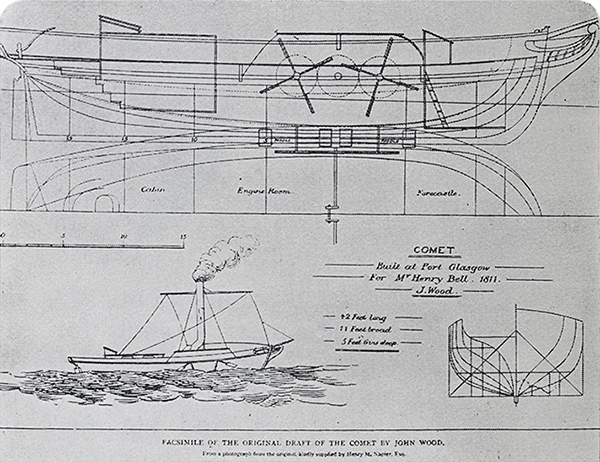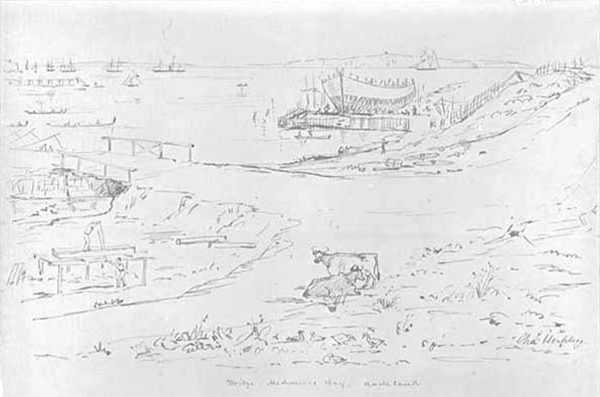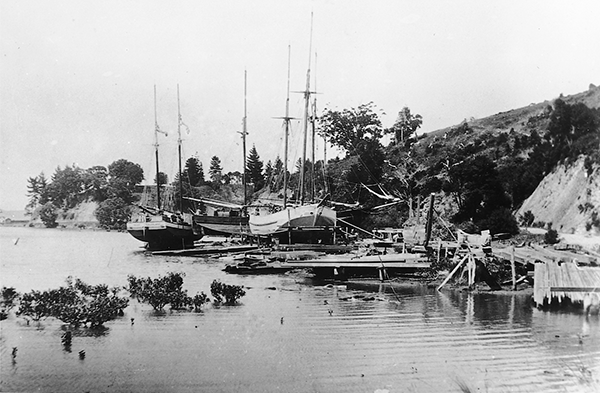Jade River: A History of the Mahurangi
Ronald H LockerFirst published 2001. Published online 2014–. This online edition is a work in progress…
Pages 129–134in printed edition
Scow-building Darrochs of the Clyde

From Steam to Sail: Said to have swung a hammer building the first commercially successful steamboat, launched on and for the Clyde in 1812, George Darroch and his sons were to spend their lives in Aotearoa building sail-powered vessels, notably the innovative, sail-age-extending New Zealand scows. image Grace’s Guide
George Darroch, born 1797, was one of six children born to James and Elizabeth née Murray, in Whitehouse. This village lies on the southern shore of Loch Tarbet, the sea-loch that is the northern limit to Kintyre. James’ line went back five generations to Mulmuroch Darroch, minister of that place. George became an apprentice shipwright at Port Glasgow. Davey Darroch had a hammer said to have been used by his ancestor in the construction of the Comet, which he had supervised. This small wooden steamer, the first passenger steamship in the world, was built in Port Glasgow in 1812, to ply the Clyde. George could indeed have worked on it, but only as an apprentice.
About 1816 at Port Glasgow, George married a widow, Nicholas Murray, daughter of James Rogerson, a customs officer. Their four children were all born there: James Watt, 1823; Robert, 1825; Mary, 1832; Nicholas Porteous, 1834. Along with other future citizens of Mahurangi, they chose to escape hard times at government expense, by shipping on the Jane Gifford.
In Auckland, George and his sons lost no time in setting to work on boatbuilding. They lived first in Wellesley Street, about where the City Art Gallery is, and built boats in Victoria Street, where they could be launched at high tide into the tidal creek which ran that far back. Later they lived in Albert Street, and built on the waterfront. Nearby fellow passengers, young Henry Niccol and his brother-in-law, Archibald Sharp, were then building ships in Mechanics Bay, about where Vulcan Lane is today. The Auckland shipbuilding establishment in 1845, according to the police census of the town, consisted of nine shipwrights, two ropemakers, a blockmaker, sawyers and blacksmiths. In that year most of these resources must have been needed for the building of the first large ship there: the brig Maukin of 146 tons, by Niccol and Sharp. It was to become the first Auckland to Sydney packet.
Darroch found his own niche, constructing small vessels for Māori owners. They had quickly perceived these to be handier than canoes for bringing in their produce, on which the new town depended. In the next decade, many Māori acquired small coastal traders and proved themselves highly capable seamen. Darroch established his clientele among Māori of the Bay of Plenty. About eight ships have been attributed to him in that period by Davey Darroch (some in error). One that he advertised for sale in November 1849 was Māori Messenger, a 17-ton schooner. Another the Nicholas, named for his wife or daughter. These and others are not in the register. Some of these small early vessels were never registered, particularly if they went to Māori owners. Three of his later Auckland, schooners, appear in the register: Highlander, New Zealander, and Argyle. The latter, registered on 3 December 1850 was the last from Auckland. During the Auckland period—probably in 1845—the elder son, James, went off to Hobart to serve an indenture as a shipwright, of which more later.

Mechanics and Shipwrights Bay: Named Mechanics Bay even when Charles Heaphy sketched the shoreline circa 1850 where George Darroch and others built vessels small and large, from its use in housing the labour force the government had brought to construct the new capital, the partly-planked vessel depicted appears to much larger than those recorded as Darroch’s pre-Mahurangi output, the largest of which was 36 feet on deck. The vessel is surely more of the scale of Niccol and Sharp’s 71-foot Maukin, but she was built before Heaphy forsook Nelson for Auckland. sketch Charles Heaphy
George Darroch must have moved to Mahurangi early in 1850, probably to be nearer a timber supply. His next ships were built at Dyers Creek. The register simply says Mahurangi, but it is remembered that they were “built between Cowans Bay and Dyers Creek”. The only suitable site fitting this description is the little bay just inside Dyers Creek, at what Davey Darroch called Carpenters Point, the northern headland of the Creek. The exposed roots of a pohutukawa show that the small flat in the bay has retreated by at least four metres. The bay was also clear of mangroves, which are now beginning to encroach. George and James Darroch purchased this land in the first sales there in 1855 (lot 90, 168 acres) and the first rates roll shows they still owned it in 1864. It seems they kept it as a source of kauri, after shifting across the harbour. My grandfather later owned this and Bradley’s adjoining block, and was still cutting kauri from it early in the twentieth century.
Soon after the shift to Dyers Creek, tragedy hit the family. On 8 July 1851 the Southern Cross reported the loss at Maketu of a vessel (unnamed), built and launched at Mahurangi by “Mr Derrick”. All hands perished, including “Mr R. Derrick, a young man highly respected by all who knew him.” The register shows that the 14-ton schooner Eagle had been registered in Auckland eight days previously, with Robert Darroch as owner. It also says the ship was lost at Whakatane in 1852, but it is often inaccurate about such things. The vessel was undoubtedly the Eagle. Robert, it seems, was taking it on its delivery voyage to Māori owners at Maketu, but never made it over the bar of the Kaituna River. The body was brought back to Mahurangi for burial. The treacherous Bay of Plenty bars claimed most of George’s ships prematurely. His third ship from the Mahurangi was named Robert in memoriam. It was a sad loss to the family circle and enterprise. George must have missed his elder son in Tasmania.
In the meantime, James Darroch was busy at Battery Point, Hobart, gaining experience in the shipyard of David Mackey, while courting his daughter. It is possible the families were related. George’s wife, Nicholas, had a sister, Martha, who married a Captain McKay and apparently went to Australia.
David Mackey, native of Fifeshire, had emigrated with his wife Margaret née Doig and six children. Four more were born in Hobart. David set up a busy shipyard, taken over in the 1870s by his son James and brothers. James adopted his nephew, a Featherstone, who in turn took over the business, which ran at Battery Point under that name until 1974 and subsequently under others. In almost a century and a half it produced an impressive tally of vessels.
Margaret Mackey, born in Scotland in 1830, married her father’s apprentice, James Watt Darroch on 9 January 1851. On 13 November their first child, George, was born. The family returned to Mahurangi via Melbourne in February 1853. It seems likely that they did not come home after the death of Robert, because James had to finish his indenture, then a seven-year stint. This implies that he left Auckland at the end of 1845.
In March 1853, the Darroch family acquired six lots in the Mahurangi Village (lots 46-8, 184-6, five acres). Here they built their home Cantyre, and on its beach set up a new shipyard. It was later known as Marriage Bay, because the first wedding on the Mahurangi took place there in 1854, between their daughter Nicholas and Henry Pulham. George was a pillar of the Presbyterian Church. The first services at the Mahurangi Heads by Reverend Bruce were held in his house. He also helped to build the Mahurangi Church. George and his family ran the post office at their home for fifty years, from 1867.
Father and son continued to build about one schooner a year. From start to finish, George built only schooners, probably because that was what his Māori customers wanted. George gave the yard up to his son, James Watt Darroch, in 1862. Until 1875, James built an even mix of cutters and schooners to serve a different clientele.
His wife Margaret was a determined woman. When she:
…saw her axe stolen by a Māori, she went to the pā and told the chief she knew which one. She picked him out and slippered him to the amusement of the others.
In 1879, James, then described as a storekeeper, gained a publican’s license. As a swan song, he built a scow, the Wairau, at Devonport in 1882. It was only an excursion; the family returned to Mahurangi. An essay, written for the school inspector in 1883 by his son James, then in Standard Four, said:
I was in Auckland three months last year going to the Devonport School.
George Darroch senior is said to have built 21 ships in New Zealand. Allowing for the 10 at Mahurangi on the list given in the appendix, he would have built 11 in Auckland. George died in 1877, and Nicholas in 1884. James and Margaret both died in 1892.
The homestead, Cantyre passed to George’s daughter, Mary (1827–1915), who had married Captain Robert Quinn (1833–1906), coastal skipper and maritime partner of John Sullivan. It stood on the terrace just above the present cottage. The older house in the bay, now labelled Cantyre, is of a later vintage.

Scow Era of their Ways: After the demise of Mahurangi boatbuilding—mostly in favour of the Waitematā Harbour, in the Whangateau Harbour, 18 kilometres north as the crow flies from where he learned his trade in Te Kapa Inlet, Mahurangi shipwright David Darroch became one of the most prolific New Zealand-scow builders. Scows, the Scot, left, Daphne, bow-to-bank, and Jane Gifford, with the stem of the next build in the foreground. image Auckland Museum
The era of the scows had begun, and the third generation of Darrochs became part of it. In 1879 a scow was launched at Makarau, Kaipara Harbour, built for Henry Palmer of Warkworth, former flourmiller, who had a kauri bush at Makarau. The builder is given as G. Darroch, and the press attributed him to the well-known Mahurangi firm. Since George senior was dead, it must have been the work of his grandson. James’ eldest son George, born in Hobart in 1851 and named after his grandfather, had probably worked in his father’s yard till its closure in 1875. The maiden voyage of the Makarau provided the first test of a New Zealand scow under severe conditions on ocean passage. She left the Kaipara loaded with logs, ran into heavy weather off North Cape and had to jettison logs, but arrived intact on the Waitematā.
It was a younger son of James who proved to be the most notable builder of the family: David “Davey” Mackey Darroch. He learned his trade at Marriage Bay. It is said that at the closure of the yard, Davey bought a yacht, persuaded an Auckland merchant to supply goods “on tick”, and became an itinerant maritime grocer. He then went ashore to be a storekeeper. The Weekly News reported on 14 May 1881: “A destructive fire occurred at the store and residence of Mr D.M. Darroch, Upper Matakana. It was totally destroyed — .” The fire did him a favour, sending him across the hill to Ōmaha, where he went back to working as a shipwright, for John Meiklejohn. He appeared when that family had launched two scows and had another on the slipway. For some reason, John then ceased to build—until his last two scows in 1888 and 1891—but Davey had grasped the potential. He took over the upper yard—at the extreme end of the Ōmaha River, where Quintals Road crosses the Tamahunga Stream. Like his father, he also married the boss’s daughter, Vida Meiklejohn, who bore him thirteen children.
Three years after the last vessel was launched in the Mahurangi Harbour, Davey launched his first scow, Una, in 1883. By the time his father-in-law had built his last in 1891, Davey had built six. In that period he had shifted to a new yard, beside the Meiklejohns’ lower yard, near the present Big Ōmaha wharf. He built his home there. A photograph of 1901, taken of the team building his masterpiece, the three-masted topsail schooner Eunice, shows that he also took over the family skills. No fewer than four Meiklejohn men appear in the group of fourteen.
In all, Davey built 32 scows at Ōmaha, but only three other vessels. Production ceased with the outbreak of the First World War. The yard reopened in Stanley Bay in 1920 as D Darroch and Sons, but only three more scows were built. The Ngahau was launched in 1921. The old man retired at Stanley Bay. He owned an elegant launch, Ronomore, in which he used to visit his old haunts in Mahurangi and Omaha. His sons Watt and Harvey Darroch built the last scows ever to be built: Owhiti in 1924, and Alwyn G in 1925. The day of the scow was over. The firm had built more scows than any other, in all, 35 out of the total of 123, although Niccol, who specialised in the larger scows, had built a greater tonnage.
